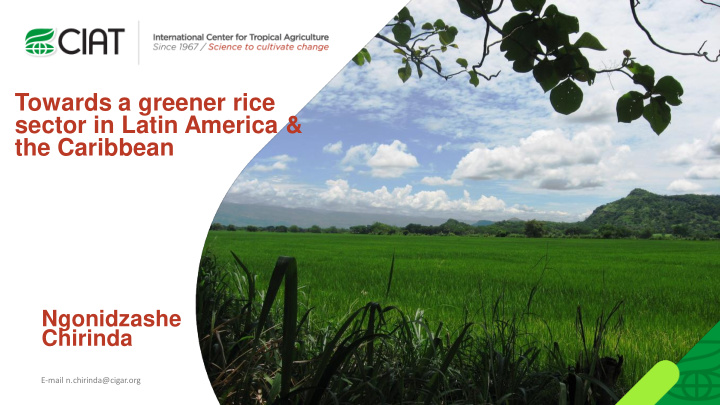



Towards a greener rice sector in Latin America & the Caribbean Ngonidzashe Chirinda E-mail n.chirinda@cigar.org
Paddy Rice Research Group Meeting EMBRAPA Clima Temperado, RS – Brazil 20-21 February, 2015 • Review on mitigation research in LAC • Concept notes & proposals for multi-site/country experiments to include: 1. Comparisons among regions, climates and production systems; 2. Modelling of GHG emission from different systems; 3. Better understanding of the soil microbiology dynamics rice paddies. 2
Presentation structure • Brazil decisions • State-of-the-art on rice research in LAC • Fundraising efforts • Modelling • Capacity building
State-of-the art of research on GHG mitigation in LAC Chirinda et al. A review of climate change mitigation options for irrigated rice systems in Latin America and the Caribbean: Key regional differences and the need for more research ( manuscript in prep ) Key observations: • Intermittent drainage of irrigated rice fields reduces CH 4 emissions by 25-65% . • Focus on quantifying the potential of tillage practices , variety choices , and nitrogen and straw management to reduce GHG emissions • Parametrization & validation of mechanistic models and other GHG calculators for LAC (i.e., DNDC) 4
Fundraising efforts • Climate and Clean Air Coalition to Reduce Short-Lived Climate Pollutants (CCAC) • Tinker foundation • Embrapa-innovative market • CGIAR Research Program on Climate Change, Agriculture and Food Security (CCAFS) - LAMNET 5
CCAC: Mitigation options to reduce CH 4 emissions in paddy rice • Stakeholder engagement to ensure adoption of smart irrigation practices (SIPs) • Information & communication on SIPs • Building financial resource base for reducing CH 4 emissions • Evaluating the technical & economic viability & environmental impact of SIPs • Build capacity of relevant stakeholders to implement SIPs and take policy actions 6
Tinker foundation: Assessment of Greenhouse Gas Emissions from Rice Systems in Latin America (GreenRice) • Multi-site/country experiments • Estimating baseline GHG emissions & exploring mitigation options • Building the capacity of regional partners in GHG research • Inform the designing and implementation of Nationally Appropriate Mitigation Actions ( NAMA s) 7
Innovative Mkt Embrapa: Validation of a novel water management strategy for Colombia and Brazil • To evaluate two AWD treatments ( mild and severe AWD ) vs. continuous flooding Treatments: • Mild AWD : Water depth allowed to decrease to 15 cm below the soil surface before irrigation • Severe AWD : Water depth allowed to decrease to 30 cm below the soil surface before irrigation 8
Modelling • We are in contact with Applied Geosolutions (AG) • AG are rewriting the DNDC model & will make the new code open source project for research use. • Code will be available on the GRA Modeling Platform (http://gramp.org.uk/) • Collaborate on the model calibration & validation developing GHG offset protocols . • Joint fundraising efforts for training and collaboration workshops. 9
How else can we reduce GHG emissions?
Methodology . Data analysis Tissue Tissue analysis collection Plant tissue preparation 12 wild rice 5 cultivated
Preliminary results - cultivated varieties Variety % Aerenchyma Methane . transmission ? NIPPONBARE 43 ? TAICHUNG NATIVE 38 ? IR-59469 34 ? TEQUING 26 ORIZICA LLANOS 26 ?
Varietal differences and effects on CH 4 emission Methane transmission Oriza glumepatula 100971
Innovation in measurements, modelling and policies (PhD students, research institutions and policy makers) 14
Recommend
More recommend